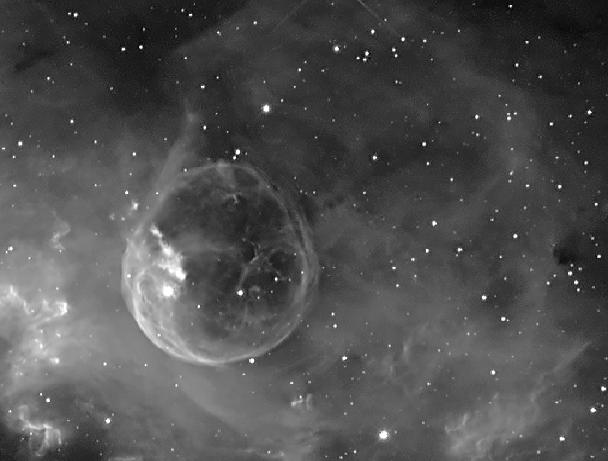|
|
|

The Bubble Nebula, NGC 7635. Original image
credit: Eric Mouquet.
A Bubble of Obsolete
Presumptions
Sep 07, 2010
The Bubble Nebula illustrates how
revolutionary progress in
theoretical understanding changes
our perceptions of the universe.
Before space
telescopes and modern telescope
technology, astronomers photographed
rings of dim light. They called them
planetary nebulae. Under the
accepted presumptions about
exploding stars, they concluded that
the rings were spherical bubbles of
hot gas. The appearance of the ring
was due to edge-brightening, the
increase of luminance from viewing a
greater depth of gas at the edge of
a sphere.
Then new telescopes and technology
enabled astronomers to get a more
detailed look. The details
contradicted the spherical model.
Astronomers found filaments, bright
spots, braided threads, overlapping
rings, rings stacked along an axis
common with the star, hourglass
shapes, coaxially aligned tubes of
evenly spaced filaments. It became
apparent that the structures were
cylindrical and that they pinched
down to slender necks in the
vicinities of the central stars.
Often, a small disk or ring could be
detected around the star (which was
usually a binary) in its equatorial
plane, like a donut on the stick of
the cylinder.
Standard gas dynamics and gravity
theories were hard-pressed to
account for these observations. Even
magnetohydrodynamics, which
incorporated some aspects of
magnetic theory, was “surprised”—an
attributive that became commonplace
as the observations flooded over the
traditional presumptions of
astronomy. Ad hoc patches and
casuistic exceptions have torn the
once-beautiful coherent fabric of
astronomy and astrophysics into an
ugly ragbag of clashing and frayed
excuses.
The promise of a new coherent theory
has risen from the accumulating
findings of the handful of
electrical discharge investigators
over the past century. Electrical
discharges in both laboratories and
nature display just this kind of
cylindrical filamentary structures,
which are called Birkeland currents.
The hourglass shape, with all the
accompanying aspects of planetary
nebulae, has been well-studied and
is called the Bennett Pinch or the
z-pinch. The field has come to be
known as plasma physics, and its
application to phenomena in space is
called plasma cosmology, which is an
accepted discipline among the many
recognized by the Institute of
Electric and Electronics Engineers
(IEEE).
A close examination of the image of
the Bubble Nebula (above) reveals
many of these characteristics.
(Color image
here.) One needs to keep in mind
that the image is looking almost
exactly down the axis into the
funnel of the hourglass, and
therefore the cylinder of current
(or cylinders: these are often
double, as in the aurora) will
appear as a circle.
At the upper right, the ring is
doubled or even tripled. That may
indicate two or three regions of
increased density that the current
passes through on its way toward the
central star, or it could reveal a
double coaxial tube structure
typical of Earth’s aurora.
(Planetary nebulae may be thought of
as stellar aurorae.) In either case,
each ring segment is composed of
evenly spaced bright spots connected
by dim radial filaments. These mark
the individual Birkeland currents
that compose the sheet current of
the tube. They can be traced both
inside the ring, as they run down to
the center of the hourglass, and
outside it, running as straight as
the ideal geometrical line.
The bright patch and curlicue on the
left side of the ring may be a
diocotron instability in the current
sheet. These instabilities are
commonly seen as the swirls that
develop in the aurora.
If the nebula is a large (on a
stellar scale) pinched current, it
carries more than enough power to
supply the radiation “load” of the
central star. Hence, the star is
likely powered by electricity
through coupling with the nebular
discharge current, rather than by
internal nuclear fusion. At the
other end of the argument, the
nebular current can’t cease to exist
beyond the limits of its optical
glow. It must be part of a circuit
that winds through the galaxy.
Electrical couplings between
circuits at different scales, from
superclusters of galaxies to planets
and even to their weather, tie the
universe into a unitary organic
electrical structure and provide the
coherent theory of cosmology that
modern astronomy has lost.
Traditional astronomy is likely to
go the way of the old astrology, and
the future study of the stars will
be done in the Plasma Cosmology
division of IEEE.
Mel Acheson
|
|
|
|
|
|
|
|
|
YouTube video, first glimpses of Episode Two in the "Symbols of an Alien Sky"
series.
|
|
|
|
|
|
|
Three ebooks in the Universe Electric series are
now available. Consistently
praised for easily understandable text and exquisite graphics.
|
|
|
|
|
|
|
|
|
|







